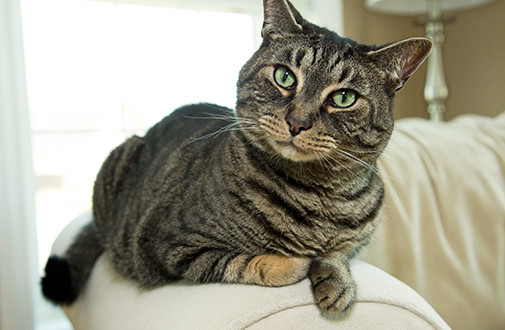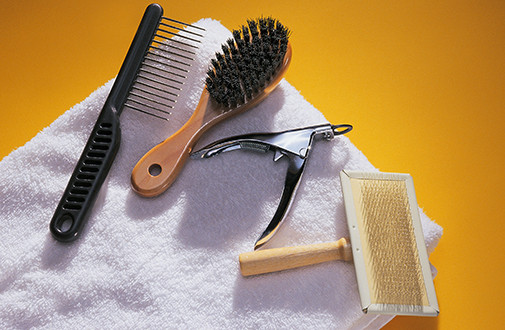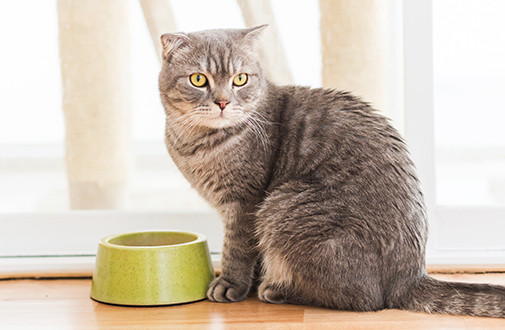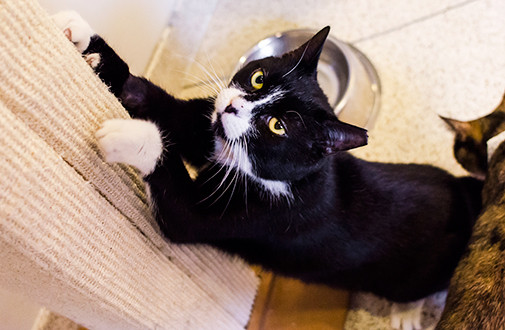Bringing a cat into your home is an exciting and rewarding experience. Cats offer companionship, affection, and endless entertainment. Properly caring for your feline friend ensures a happy, healthy life together. Whether you’re a first-time cat owner or looking to refresh your knowledge, this guide provides essential tips on How To Take Care Of A Cat, covering everything from basic needs to creating a loving environment.
Essential Cat Care Basics
 Two kittens in a basket, one looking at the camera, the other sleeping
Two kittens in a basket, one looking at the camera, the other sleeping A person petting a tabby cat on a couch
A person petting a tabby cat on a couch
Feeding Your Cat
Nutrition is fundamental to your cat’s well-being. Choosing the right food and establishing good feeding habits are crucial aspects of cat care.
- High-Quality Cat Food: Opt for premium, brand-name kitten or cat food appropriate for your cat’s age and health status. Consult your veterinarian to determine the best diet for your cat, considering factors like age, activity level, and any specific health needs.
- Taurine is Essential: Cats require taurine, an essential amino acid vital for heart and eye health. Ensure the food you select is balanced for your cat’s life stage and contains sufficient taurine.
- Fresh Water Daily: Always provide fresh, clean water. Wash and refill your cat’s water bowls daily to encourage hydration.
- Treats in Moderation: Limit treats to no more than 5-10% of your cat’s daily diet to avoid nutritional imbalances and weight gain.
- Baby Food Caution: While baby food might seem appealing for sick or picky cats, carefully read labels. Avoid any baby food containing onion or garlic powder, as these are toxic to cats.
- Monitor Appetite and Health: If your cat exhibits anorexia, diarrhea, vomiting, or lethargy for more than two days, seek veterinary care promptly.
- Foods to Avoid: Be aware of human foods that are toxic to cats. Onions, garlic, chocolate, grapes, and alcohol are just a few examples. Refer to resources like the ASPCA’s “People Foods to Avoid Feeding Your Pets” for a comprehensive list.
 A ginger cat eating from a blue bowl on a wooden floor
A ginger cat eating from a blue bowl on a wooden floor A person brushing a long-haired white cat
A person brushing a long-haired white cat
Grooming Your Cat
Regular grooming is an essential part of cat care, contributing to both hygiene and bonding.
- Regular Brushing: Most cats are self-grooming but benefit significantly from regular brushing or combing. Frequent brushing keeps their coat clean, reduces shedding around your home, and minimizes hairballs. The frequency depends on your cat’s coat type, with long-haired cats needing daily attention and short-haired cats requiring less frequent brushing.
- Bathing – Rarely Necessary: Cats rarely need baths unless they get into something messy or are unable to groom themselves due to age or illness. Over-bathing can dry out their skin.
- Nail Trimming: Trim your cat’s nails every few weeks to prevent overgrowth, painful scratches, and damage to furniture. Use cat-specific nail clippers and only trim the clear tip of the nail to avoid the quick (the pink part containing blood vessels and nerves).
Handling Your Cat
Gentle and proper handling builds trust and ensures your cat’s comfort and safety.
- Lifting Correctly: To pick up your cat, place one hand behind their front legs and the other supporting their hindquarters. Lift gently and smoothly.
- Never Scruff or Grab Legs: Never pick up a cat by the scruff of the neck or by their front legs as this can cause pain and fear.
Housing Your Cat
Providing a safe and comfortable home environment is crucial for your cat’s well-being.
- Indoor Safety: Cats are safest and healthiest indoors. Indoor cats live significantly longer lives than outdoor cats, avoiding dangers like traffic, predators, diseases, and parasites.
- Safe Indoor Space: Create a safe and stimulating indoor environment. Provide scratching posts, toys, climbing structures, and window perches for entertainment and exercise.
- Personal Space: Your cat needs their own clean, quiet space to sleep and rest. Provide a comfortable cat bed lined with a soft, washable blanket or towel. Wash bedding regularly to maintain hygiene.
Identification for Your Cat
Proper identification is vital for your cat’s safety, whether they are indoor-only or venture outside.
- Safety Collar and ID Tag: If your cat goes outdoors, they must wear a safety collar with an ID tag. A safety collar with an elastic panel or breakaway clasp will allow your cat to escape if the collar gets caught. The ID tag should include your phone number and address.
- Microchipping: For both indoor and outdoor cats, consider microchipping. A microchip, implanted under the skin, provides permanent identification and significantly increases the chances of reuniting with your cat if they get lost. Ensure your contact information linked to the microchip is always up-to-date.
Litter Box Essentials
A clean and accessible litter box is fundamental for a cat’s hygiene and comfort.
- Location, Location, Location: Place the litter box in a quiet, accessible location, away from food and water bowls. In multi-story homes, have at least one litter box per floor.
- Avoid Relocation: Cats are sensitive to change. Avoid moving the litter box unless absolutely necessary. If you must move it, do so gradually, a few inches per day.
- Scoop Daily, Clean Weekly: Scoop solid waste from the litter box at least once daily. Completely empty, wash with mild, unscented detergent, and refill the litter box at least once a week (or more frequently if needed). Clumping litter may allow for less frequent full changes.
- Avoid Harsh Cleaners and Scents: Do not use ammonia, deodorants, or heavily scented cleaners, especially lemon-scented products, as they can deter cats from using the litter box.
- Litter Box Aversion: If your cat stops using their litter box, consult your veterinarian. Medical conditions like urinary tract infections can cause litter box avoidance. Behavioral issues can also contribute.
 A grey cat using a white litter box
A grey cat using a white litter box A ginger cat scratching a scratching post
A ginger cat scratching a scratching post
Scratching Needs of Cats
Scratching is a natural and essential behavior for cats. Providing appropriate outlets for scratching protects your furniture and satisfies your cat’s instincts.
- Why Cats Scratch: Cats scratch to remove the outer sheath of their claws, sharpen their claws, mark territory, and stretch their muscles.
- Scratching Posts and Pads: Provide sturdy scratching posts, ideally at least three feet tall, covered in rough materials like sisal, burlap, or tree bark. Ensure the post is stable and won’t wobble. Scratching pads are also a good addition.
- Nail Trimming as Support: Regular nail trimming helps keep claws blunt, reducing damage from scratching, but it doesn’t eliminate the need for scratching behavior.
Cat Health and Veterinary Care
Preventative and responsive healthcare are critical components of responsible cat ownership.
- Annual Veterinary Check-ups: Schedule annual veterinary examinations for your cat, even if they seem healthy. Regular check-ups allow for early detection of health issues and ensure your cat receives necessary vaccinations and parasite prevention.
- Vaccinations: Your veterinarian will recommend a vaccination schedule based on your cat’s age, lifestyle, and health risks. Core vaccines are generally recommended for all cats, with additional vaccines depending on individual needs.
- Prompt Care for Illness or Injury: Seek veterinary attention immediately if your cat shows signs of illness or injury. Do not delay treatment, as early intervention often leads to better outcomes.
Medications and Poisons: What to Avoid
Protecting your cat from toxins and administering medication safely are vital.
- Veterinarian-Prescribed Medication Only: Never give your cat any medication, including over-the-counter drugs, unless specifically prescribed by your veterinarian. Many human medications are toxic to cats.
- Suspected Poisoning: If you suspect your cat has ingested a poisonous substance, immediately contact your veterinarian or the ASPCA Animal Poison Control Center for 24/7 assistance at (888) 426-4435. Keep the packaging of the suspected poison if possible.
Spaying and Neutering Your Cat
Spaying or neutering is a responsible choice for your cat’s health and helps control pet overpopulation.
- Recommended Timing: Spay female cats and neuter male cats by five months of age. Consult your veterinarian for the best timing for your cat.
- Health and Behavioral Benefits: Spaying and neutering offer numerous health benefits, including reducing the risk of certain cancers and infections. It also reduces unwanted behaviors like spraying, roaming, and yowling, contributing to a calmer and healthier pet.
Vaccinations for Cats
Vaccinations are a cornerstone of preventative cat healthcare, protecting against serious and potentially fatal diseases.
- Core Vaccinations: Discuss core vaccinations with your veterinarian. These typically include protection against feline distemper (panleukopenia), feline viral rhinotracheitis, feline calicivirus, and rabies.
- Lifestyle-Based Vaccinations: Depending on your cat’s lifestyle (indoor vs. outdoor, exposure to other cats), your veterinarian may recommend additional vaccines, such as feline leukemia virus (FeLV) vaccine.
- Individualized Schedule: Your veterinarian will tailor a vaccination schedule to your cat’s specific needs, ensuring they receive optimal protection throughout their life.
Cat Supply Checklist
Being prepared with the right supplies makes cat care easier and more enjoyable. Here’s a checklist to get you started:
- Premium-brand cat food (kitten or adult, as appropriate)
- Food dish
- Water bowl
- Interactive toys (wands, balls, puzzle toys)
- Brush (appropriate for coat type)
- Comb (for longer-haired cats)
- Safety cat collar with ID tag
- Scratching post or scratching pad
- Litter box and litter
- Cat carrier (for vet visits and travel)
- Cat bed or box with warm blanket or towel
By following these guidelines, you’ll be well-equipped to provide excellent care for your cat, ensuring a long, happy, and healthy companionship. Remember, consistent care, attention, and love are the most important ingredients in nurturing a thriving bond with your feline friend.


